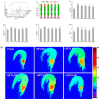Effect of Liquid Nitrogen Freezing Temperature on the Muscle Quality of Litopenaeus vannamei
- PMID: 38137263
- PMCID: PMC10742912
- DOI: 10.3390/foods12244459
Effect of Liquid Nitrogen Freezing Temperature on the Muscle Quality of Litopenaeus vannamei
Abstract
The implications of different liquid nitrogen freezing (LNF) temperatures (-35 °C, -65 °C, -95 °C, and -125 °C) on the ice crystal and muscle quality of white shrimp (Litopenaeus vannamei) were investigated in this essay. The results showed that better muscle quality was maintained after LNF treatment compared to that after air blast freezing (AF) treatment. As the freezing temperature of liquid nitrogen decrease, the freezing speed accelerated, with the freezing speed of LNF at -125 °C being the fastest. However, an excessively fast freezing speed was not conducive to maintaining the quality of shrimp. Among all the freezing treatments, LNF at -95 °C led to the lowest thawing losses and cooking losses, and the highest L* values, indicating that LNF at -95 °C could keep the water holding capacity of frozen shrimp better than that with other freezing methods. At the same time, LNF at -95 °C resulted in higher water holding capacity, and hardness values for shrimps than those with other frozen treatments (p < 0.05). In addition, the results of the water distribution of shrimps showed that treatment with a -95 °C LNF reduced the migration rate of bound and free water. Meanwhile, the microstructural pores of shrimps in the -95 °C LNF group were smaller, indicating that the ice crystals generated during -95 °C LNF were relatively smaller than those generated via other frozen treatments. In conclusion, an appropriate LNF temperature (-95 °C) was beneficial for improving the quality of frozen shrimp, and avoiding freezing breakage.
Keywords: Litopenaeus vannamei; ice crystal; liquid nitrogen freezing; muscle quality; temperature.
Conflict of interest statement
The authors declare no conflict of interest.
Figures





Similar articles
-
Effects of liquid nitrogen freezing at different temperatures on the quality and flavor of Pacific oyster (Crassostrea gigas).Food Chem. 2023 Oct 1;422:136162. doi: 10.1016/j.foodchem.2023.136162. Epub 2023 Apr 18. Food Chem. 2023. PMID: 37126955
-
Effect of static magnetic field-assisted freezing at different temperatures on muscle quality of pacific white shrimp (Litopenaeus vannamei).Food Chem. 2024 Apr 16;438:138041. doi: 10.1016/j.foodchem.2023.138041. Epub 2023 Nov 23. Food Chem. 2024. PMID: 38007954
-
Insight into muscle quality of white shrimp (Litopenaeus vannamei) frozen with static magnetic-assisted freezing at different intensities.Food Chem X. 2022 Nov 23;17:100518. doi: 10.1016/j.fochx.2022.100518. eCollection 2023 Mar 30. Food Chem X. 2022. PMID: 36478709 Free PMC article.
-
Research progress on quality deterioration mechanism and control technology of frozen muscle foods.Compr Rev Food Sci Food Saf. 2022 Nov;21(6):4812-4846. doi: 10.1111/1541-4337.13040. Epub 2022 Oct 6. Compr Rev Food Sci Food Saf. 2022. PMID: 36201389 Review.
-
Effect of low-temperature preservation on quality changes in Pacific white shrimp, Litopenaeus vannamei: a review.J Sci Food Agric. 2019 Nov;99(14):6121-6128. doi: 10.1002/jsfa.9905. Epub 2019 Sep 4. J Sci Food Agric. 2019. PMID: 31260117 Review.
References
-
- Hsu W.-H., Lai Y.-J., Wu S.-C. Effects of the anti-microbial peptide pardaxin plus sodium erythorbate dissolved in different gels on the quality of Pacific white shrimp under refrigerated storage. Food Control. 2017;73:712–719. doi: 10.1016/j.foodcont.2016.09.025. - DOI
-
- Nakazawa N., Okazaki E. Recent research on factors influencing the quality of frozen seafood. Fish. Sci. 2020;86:231–244. doi: 10.1007/s12562-020-01402-8. - DOI
-
- Pilipovik M., Riverol C. Reducing Operating Costs in Freezing Processes Using Asymmetric Distribution of Sprays. J. Food Process. Eng. 2013;36:254–255. doi: 10.1111/j.1745-4530.2011.00668.x. - DOI
-
- Ketata M., Desjardins Y., Ratti C. Effect of liquid nitrogen pretreatments on osmotic dehydration of blueberries. J. Food Eng. 2013;116:202–212. doi: 10.1016/j.jfoodeng.2012.10.035. - DOI
Grants and funding
- 2021E05015/Ocean Young Innovative Talents Project of Zhanjiang
- 2023A1515011513/Guangdong Basic and Applied Basic Research Foundation
- 2022A05036/Special Fund for Scientific and Technological Innovation Srategy of Guangdong Province
- 2022-440000-45060100-9680/General Transfer Payment Fund Project of Fishery Development Support Policy in Guangdong Province in 2022
LinkOut - more resources
Full Text Sources
Research Materials

